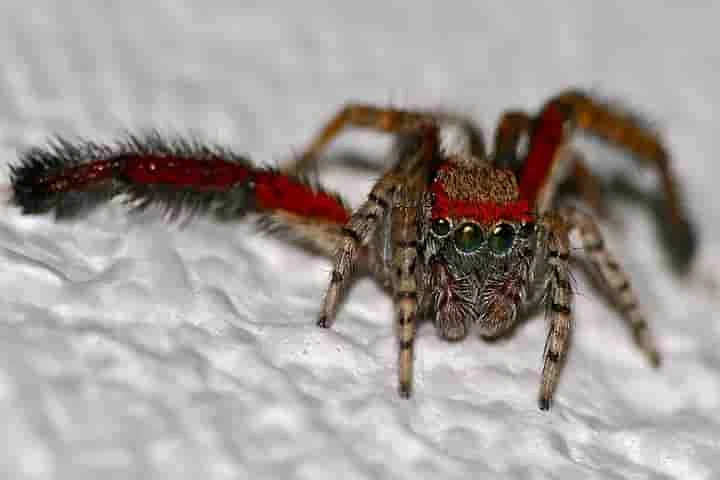

The captivating red in jumping spider, scientists suggest could be to camouflage from the enemies
<p>
<strong>Beautiful to look at as they don bright hues, the jumping spiders make a pretty sight yet there is one among them that despite being vividly colourful is unable to see and appreciate colour, according to an article in sciencedaiy.com</strong></p>
<p>
It was Nathan Morehouse, who along with the Cynthia Tedore-led international team of researchers found this jumping spider.</p>
<p>
While Morehouse is an associate professor at the University of Cincinnati, Tedore is research associate from the University of Hamburg.</p>
<p>
Examining the common jumping spider or Saitis barbipes which is found in Europe and North Africa Morehouse found that the males of the species have a furry red crown and legs. This seemed to be an addition to their complex courtship dances that they performed to romance females.</p>
<p>
David Outomuro the first co-author of the study observed: <a href="https://www.sciencedaily.com/releases/2022/01/220114103016.htm" rel="nofollow">&quot;We assumed they were using</a> colour for communication. But we didn&#39;t know if their visual system even allowed them to see those colours.&rdquo;</p>
<p>
Outomuro is a UC postdoctoral researcher now at the University of Pittsburgh who co-authored the study with Mateusz Glenszczyk, a University of Hamburg researcher. The journal The Science of Nature published the study.</p>
<p>
Spiders were collected in Slovenia by the researchers to be studied in a lab in Germany. With the aim to identify photoreceptors that are sensitive to colours or varied light wavelengths, the specimens were studied using microspectrophotometry at UC. The scientists were in for a surprise as contrary to their expectation, they were unable to find any red photoreceptor. They also scrutinised for coloured filters in the eye that shift green sensitivity to red, but found none.</p>
<p>
What they discovered were patches on the spider that absorb ultraviolet wavelengths strongly making them look &ldquo;spider green&rdquo; to other jumping spiders. To the jumping spiders the evocative red colours to us comes across as no different than black markings.</p>
<p>
<strong>Also read: <a href="https://www.indianarrative.com/science-news/what-makes-a-mother-kangaroo-s-pouch-warm-and-protective-142082.html">What makes a mother Kangaroo&rsquo;s pouch warm and protective?</a></strong></p>
<p>
According to Morehouse: &quot;It&#39;s a bit of a head-scratcher what&#39;s going on here. We haven&#39;t solved the mystery of what the red is doing.&quot;</p>
<p>
Colours donned by creatures serve several purposes including camouflaging, displaying toxicity to the predators, frightening enemies or attracting mates. As per Morehouse, at times it is not clear as to what the bright hue stands for.</p>
<p>
He remarked: &quot;We spent a lot of time talking about it as a group. What else could it be? I feel there&#39;s an interesting story behind the mystery.&rdquo; As per the study&rsquo;s senior author Tedore, the results were surprising.</p>
<p>
Tedore said: &ldquo;Males have bold red and black colouration on their forward-facing body surfaces which they display during their courtship dances; whereas, females lack red colouration altogether. This initially suggested to us that the red colour must play some role in mate attraction.&rdquo;</p>
<p>
She went on to add: &quot;Instead, we found that red and black are perceived equivalently, or nearly so, by these spiders and that if red is perceived as different from black, it is perceived as a dark &#39;spider green&#39; rather than red.&rdquo;</p>
<p>
<strong>Also read: <a href="https://www.indianarrative.com/science-news/panama-boy-discovers-that-azteca-ants-are-skilled-engineers-140496.html">Panama boy discovers that Azteca Ants are skilled engineers</a></strong></p>
<p>
The study proposed that the red and black colours could possibly help in better camouflaging.</p>
<p>
Sharing her views on this, Tedore remarked: &quot;For predators with red vision, at natural viewing distances, the spider&#39;s red and black colour patches should blur together to become an intermediate orangish-brownish colour, which would help the spider blend in with its leaf litter habitat better than all-black colouration would.&rdquo;</p>
<p>
Summing up the discovery, Morehouse aptly said that this discovery is a reminder of how animals can sometimes perceive the world in ways far different from us.</p>
Taiwan's military is prioritising combat readiness as a key aspect of deterrence due to escalating…
Calling for an increase in the speed of development, Prime Minister Narendra Modi said on…
The Scottish Government has reaffirmed its commitment to supporting religious freedom and human rights for…
Tara Chand Baloch, the President of the Baloch American Congress and a former Cabinet minister…
In a groundbreaking study, researchers from McGill University have identified nine biological markers in the…
India, in a firm and unequivocal statement at the United Nations Security Council (UNSC), accused…